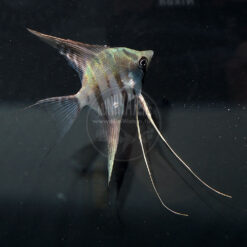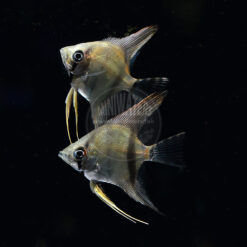Pterophyllum cf. scalare “Rio Nanay”, Wild Peruvian Angelfish
$45.00 – $95.00
Pretty straightforward, it seems a lot of different angelfish are being exported as Peruvian Altums from the Rio Nanay, but to be fair, one can never really say for certain. These fish are being offered as purchased, as “Rio Nanay” Angels, and they fit the mold reasonably well. Learn more below:
Description
Pretty straightforward, it seems a lot of different angelfish are being exported as Peruvian Altums from the Rio Nanay, but to be fair, one can never really say for certain. These fish are being offered as purchased, as “Rio Nanay” Angels, and they fit the mold reasonably well. There is some debate over whether the Rio Nanay Angelfish are in fact Pterophyllum scalare, or represent a new, distinct species. There is also some disparity regarding how these angelfish should look, and in past personal purchases it appears that at times multiple variants are being sold into the trade as Rio Nanay or Peruvian Altum. This is all further muddled by the fact that these fish change appearance as they age.
Furthermore, it sounds like there is a range of phenotype and appearance within the Rio Nanay river system, with the more brightly colored and heavily patterned fish being supposedly found further upstream. Others suggest that coloration is, to some extent, a byproduct of good captive husbandry with quality feeds. It is simply possible that both claims have merit. As such, consider these fish shown in the photos, and I’d ask that you consider they may not look any “better” than what you see shown. That way, if they do improve further with age, you’ll consider it a pleasant surprise and the result of your good care!
I don’t rush the sale of fish like this; the fish offered at the time of this listing had been well-conditioned for two months, and put through some prophylactic care as well. Wild angels can be touchy, if upon receiving these they start to breath heavy and show weak appetites, a quick rise in tank temps to 88-90F can quickly resolve this. Our fish are probably more expensive than other vendors offering “similar” items for two simple reasons. First, they’re passing on the early losses to happen in your tank; we dealt with those here so you wouldn’t have to. Second, they’re not putting in the time and care conditioning the fish. I believe you get what you pay for, and I don’t release fish until I believe they are truly ready!
Angelfish are generally sized by body size / diameter when young; dime, nickle, quarter, half-dollar. Beyond that size range, you are generally dealing with young adults, adults, and extra large type fishes.
Additional information
| Scientific Name | Pterophyllum cf. scalare |
|---|---|
| Geographic Location | Peru, Rio Nanay |
| Wild-Caught | |
| Sizes Available | Young Adult, Extra Large |
| SeriouslyFish.com Link | http://www.seriouslyfish.com/species/pterophyllum-scalare/ |
| FishBase Link | http://www.fishbase.org/summary/Pterophyllum-scalare.html |
| Wholesale Available | No |
Related products
Angelfish
Angelfish
Angelfish
















